(Kilcoo Camp director David Latimer holding what appears to be a sacred pipe at an event in 2008, which was pulled from camp’s website.)
Julien Gignac
APTN National News
Two southwestern Ontario summer camps catering to non-Indigenous boys aged seven to 16 conduct Indigenous-themed rituals, which include dancing around fires wearing headdresses, painted faces and bodies.
Kilcoo Camp in Minden, Ont. and Camp Ponacka situated near Bancroft, Ont. are privately owned and operated camps for boys which cost roughly $4,000 a month.
Neither shy away from taking part in practices that could be considered off-colour to Canadians according to pictures lifted from their websites that reveal campers and camp directors themselves donning headdresses and Indigenous regalia.
Some have painted their bodies red. Others can be seen standing stoically around towering fires.
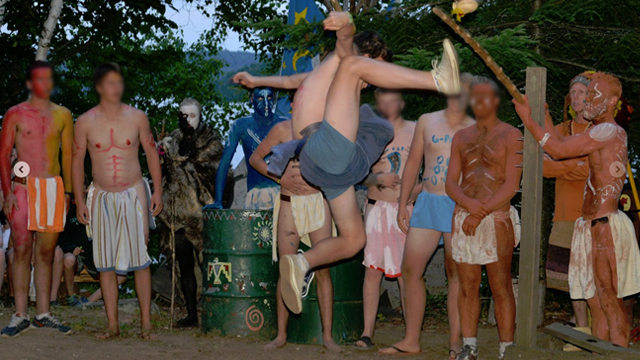
Chief Lance Haymond of the Eagle Village First Nation in Kipawa, Quebec finds it offensive.
“Redface to them may be a sign of respect for our culture, but to me it’s an insult,” said Haymond. “I think there are two options: stop doing it, or bring in First Nations people who are close to the camp and work with them to bring in a cultural component that does not make a mockery of our culture.
Haymond said the role playing gives the campers a “misguided impression of First Nations people.”
David Latimer, has been the camp director at Kilcoo since 1985.
He spoke with APTN about the “Grand Councils.”
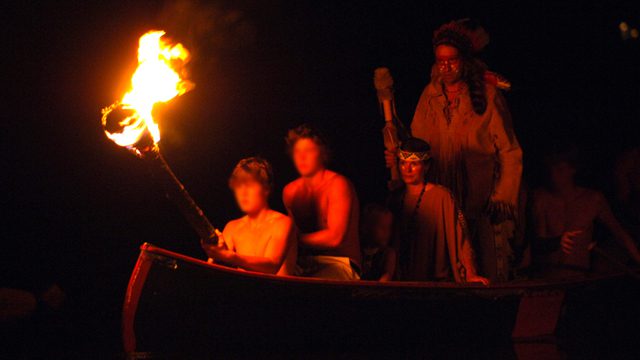
“Years ago they’d put on paint and stuff like that and we didn’t understand what it meant and it wasn’t for us, it wasn’t our place,” said Latimer. “We’re very clear to the kids that this is not an authentic thing—we’re honouring those who came before us.”
An image taken last summer posted on Kilcoo’s Twitter feed shows a young man with a face painted white and red, flexing faux tribal tattoos, hoisting a flag high with an image of a trout and the word Algonquin plastered across the shred of burlap.
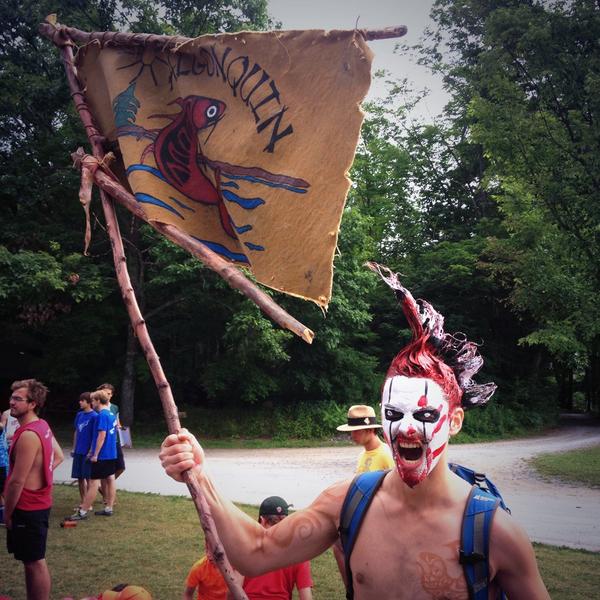
Kilcoo has an annual event called “Bushpede” where the camp divides boys into two “tribes”—the Algonquin and Iroquois. People proceed to dress up and compete in a variety of different games.
“This special day culminates in Grand Council, homage to the traditions of Native Canadians,” says Kilcoo’s website. “Grand Council is a spectacle of fire, colours, dance, stories, games and song. It is certainly an experience unique to summer camp.”
Pictures on the camp’s website from 2008 to 2012 show Latimer and other staff members dressed in aboriginal attire — the campers busy arm wrestling by fireside, playing tug of war and chopping wood, some painted blue, others red.
“Our [event] is more the spirituality of the elements — the land, the water — not so much about the aboriginal part of it,” said Latimer. “What we talk about is what the Indigenous people did years ago, celebrate the end of a day with a fire, games and that’s about it.”
Latimer said that there are currently no people who identify as Indigenous at the camp.
Photographs pulled from Camp Ponacka’s website reveal what took place last summer. The camp director on a horse wearing a headdress leading boys, who are also wearing headdresses, down a dirt road. Later, pictures show a bonfire with campers wearing beach towel loincloths and painted red, black and blue.
Ponacka’s camp director Don Bocking refused to comment on the issue.
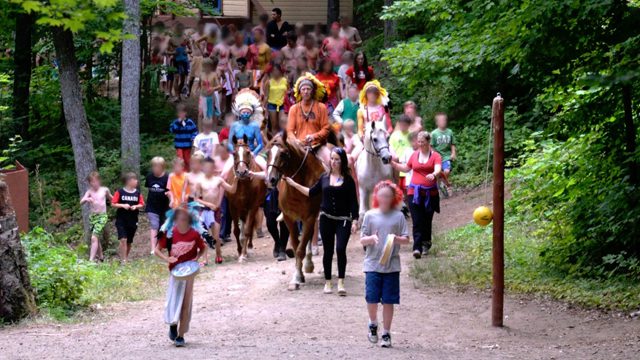
Jennifer Adese is an assistant professor at Carleton University whose research interests include racism, colonization and racialization.
Adese, who is Metis, said that what these camps are choosing to adopt are not actual aspects of Indigenous cultures grounded in the real world.
“They’re generating aspects from fantastical places that come from this history of imagining what a headdress may look like, or imagining what Indian clothes might look like,” she said. “To me, that’s what connects it to racial stereotypes rather than cultural appropriation.”
The consequence is that young people are being ill-informed, said Adese.
“People often doing these things often don’t consider it as racism,” she said. “They haven’t been taught how or why this is racist—this is part of the culture that people have been brought up in, especially within Canada and the U.S. It’s been so normalized that these kinds of representations are OK to them.”
For years the camps have been holding these events at the end of July.
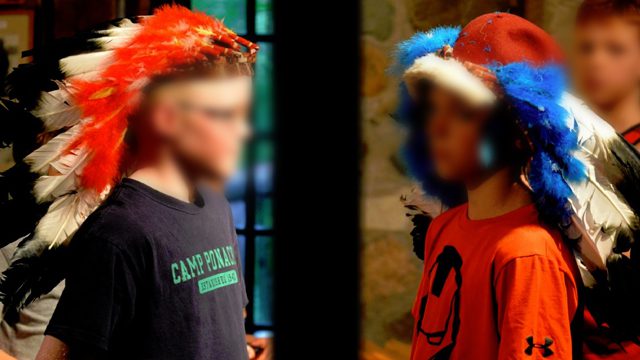
This year, there is no word that they won’t take place.
“You’re working with a bunch of young, impressionable people,” said Chief Haymond. “These people are eventually going to become lawyers, or future leaders and the basis of what they should be starting off in is our real history.”





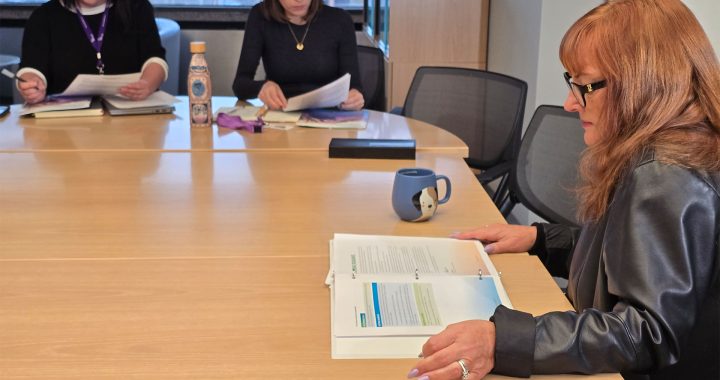

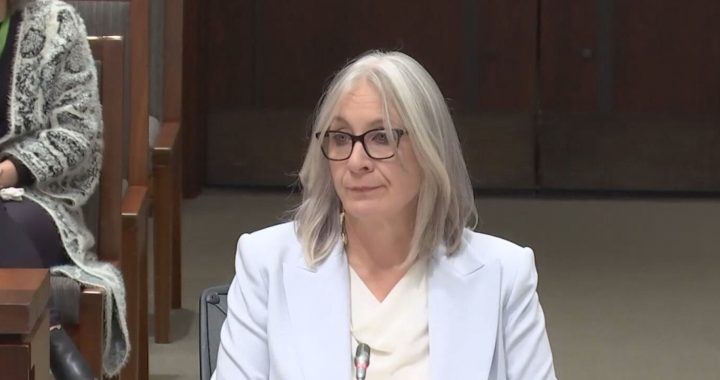
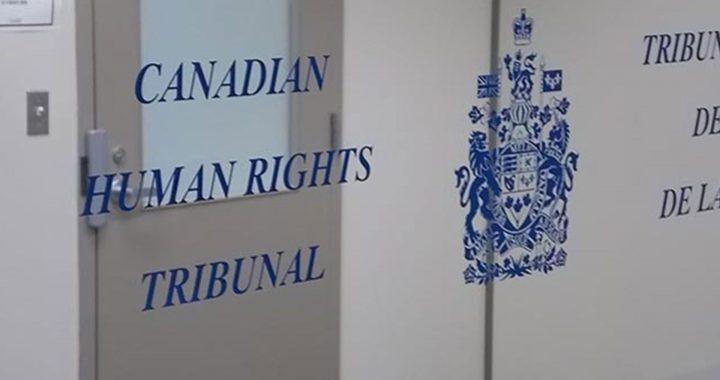
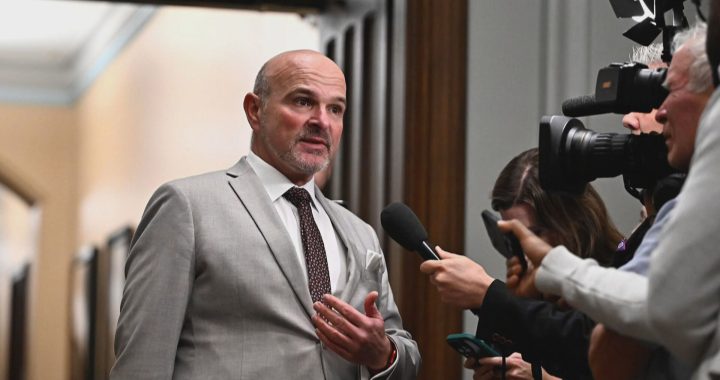
Being a previous camper at camp Ponacka, I can say that they are in no way, intentionally offending anybody. The head dresses and loin cloths can be removed from the council but in no other way is it offensive.
The council was always fun and all it was, was just lots of fun games and a campfire. Don is a great man who means no harm and I’m sure he has done what he can so that nobody is offended.
This city boy went to summer camp when he was younger . I fondly remember canoe trips, getting close to nature, the ‘mock’ native ceremonies and, yes, the tribal war games (kids will be kids after all !). Maybe I was young and impressionable – but what I do know is that this experience gave me a lifelong deep respect for nature, our country and the spirituality, strength and resourcefulness of those who came before us.
Give the camps and kids a little credit and help them along. Otherwise they will learn about native culture in textbooks, museums and (worst of all) the media.
I agree with Mr. Pilon. Lighten up, get out a peace pipe (no offense intended) and let’s have our kids celebrate and hopefully learn something ! I’m also convinced the camps will welcome the input of knowledgeable members of the 1st nations communities who truly want to build some bridges and pass on some real knowledge. I heard that Ponacka removed all references to tribal gear from their activities this summer. What do you think these (impresionnable) kids read into this action in forging their opinions on our 1st nations ? if we lower the debate to the level that our media want’s to give it – it’s another lost opportunity.
Best to all
Richard
Why aren’t the non natives interested in the Hebraic aspect of the languages of which are Ancient Hebrew, Koine Greek, Aramaic, Ugarit, Sumerian even Assyrian.
The etymological parent / child root words are Semetic. Or are the non natives thinking to get spiritual stuff and invoke demons to become better at Satanism. LMFAO!!!!!
Well its great to see my culture being used in people having fun & unlike Chief Lance Haymond of Eagle Village you should be proud that they are interested in the Algonquin culture & its sad that we were not allowed to demonstrate proper dress code & dance of our ancestors cause the Canadian government forbided these practice. Some of these demanstrators have Native blood & had no one to teach our ways but what they read in books.
This is unacceptable and the camp director owner and staff should feel ashamed of their lack of cultural sensitivity. In 2015, this is really still happening? Unbelievable.
I sent my son to a summer camp that was culturally respectful. They gave the children a pinch of tobacco and each child had a turn to give thanks for their fav part of the day or whatever they wished. As an aboriginal person, i was honored that the were culturally inclusive in a respectful way. Im thankful that the local community and my first nation have such a great relationship…and that there is cultural education to minimize racism.
This is ridiculous.
For the First Time in History- First Nations Can Remove those who Oppress them- Get Reg- and Get READY- and ROCK THAT VOTE—- its the only way to START THE Healing and Reconsideration – IS VOTING- Get out and have your VOICE HEARD- Spread the WORD— YOU HAVE THE POWER– ROCK THE VOTE